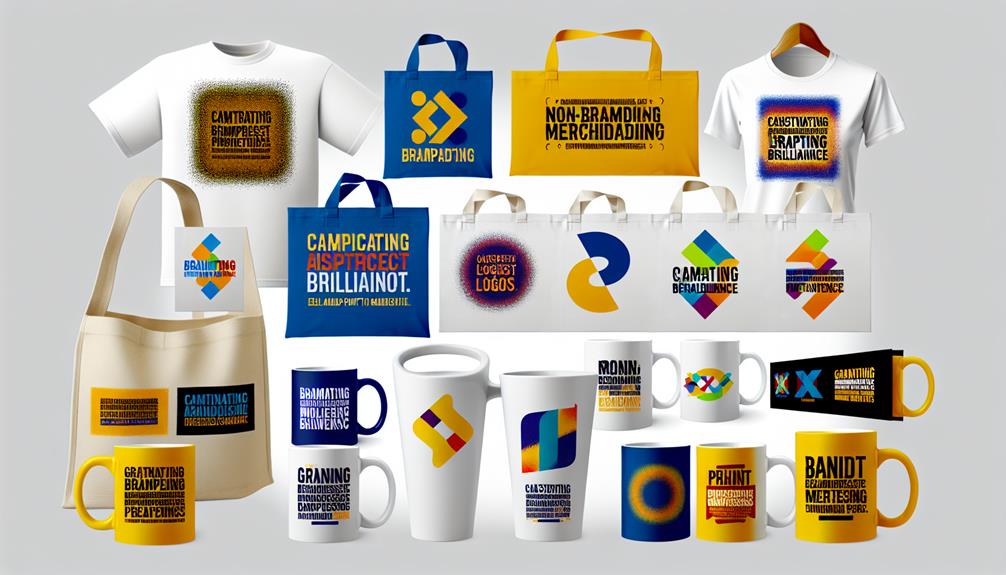You might be surprised to discover the impact that traditional prints can still have in today's digital marketing landscape. While the digital domain often dominates discussions, the power of well-crafted print materials in marketing strategies cannot be underestimated. From evoking nostalgia to creating a tangible connection with your audience, prints have a unique ability to cut through the digital noise and make a lasting impression. So, how can you leverage this timeless medium to elevate your brand's presence and drive consumer engagement effectively?
Key Takeaways
- Prints in marketing are visual materials like brochures and posters.
- They represent a brand's identity and messaging.
- Prints leave a lasting impression on the audience.
- They engage the target audience and enhance brand recognition.
- Effective print strategies include creative design and personalized content.
Definition of Prints in Marketing
To truly grasp the essence of marketing prints, envision them as the vibrant heartbeat of your brand's visual storytelling. In the domain of marketing, prints refer to any visual material used to communicate with your audience. These materials can include brochures, business cards, posters, flyers, and even packaging designs. Fundamentally, prints are tangible representations of your brand's identity and messaging.
An important aspect of prints in marketing is their ability to leave a lasting impression on your audience. For example, a beautifully designed brochure can captivate potential customers and convey the values of your brand effectively. Similarly, a creatively crafted business card can make a strong statement about your professionalism and attention to detail.
In essence, prints in marketing serve as powerful tools to engage with your target audience, build brand recognition, and communicate your unique selling points. By understanding the definition and importance of prints in marketing, you can leverage them effectively to enhance your brand's visual presence and storytelling.
Types of Prints Used
In exploring the domain of prints in marketing, it is important to understand the diverse array of print materials that can be utilized to engage with your audience effectively. Print advertising has evolved beyond traditional methods to incorporate various print mediums, each offering unique opportunities to showcase your brand. From brochures and flyers to posters and business cards, the design possibilities are endless.
When delving into the world of print advertising, it is essential to stay updated on current trends. Print mediums continue to adapt and change, with innovations such as interactive print ads and personalized prints gaining traction. By staying informed about emerging trends, you can make sure that your print materials remain fresh and engaging to your target audience.
In today's fast-paced digital world, leveraging the power of print advertising can provide a tangible and memorable experience for consumers. By exploring different print mediums and design strategies, you can create impactful campaigns that resonate with your audience and set your brand apart from the competition.
Importance of Prints in Campaigns
Amidst the ever-evolving landscape of marketing strategies, prints play a pivotal role in campaigns by offering a tangible and impactful way to connect with your target audience. Prints in advertising provide a unique opportunity to engage with customers on a physical level, leaving a lasting impression that digital mediums sometimes struggle to achieve. The visual impact of a well-designed print piece can evoke emotions, convey messages, and drive action. Integrating prints into your marketing campaigns can greatly enhance brand recognition and recall among consumers. Below is a table highlighting the importance of prints in campaigns:
| Importance of Prints in Campaigns |
|---|
| Creates Tangible Connection |
| Enhances Brand Recognition |
| Drives Emotional Engagement |
Harnessing the power of prints in your advertising efforts can set your campaigns apart from the digital noise, offering a more personal and memorable experience for your audience.
Effective Strategies for Print Marketing
Engage your audience effectively through innovative print marketing strategies that captivate and inspire action. To make your print materials stand out and leave a lasting impact, consider the following strategies:
- Utilize Creative Design: Incorporate eye-catching visuals, bold colors, and unique layouts to grab attention and convey your message effectively. Creative design elements can make your print materials memorable and increase engagement.
- Explore Various Distribution Methods: Think beyond traditional methods and explore new ways to distribute your print materials. Consider partnerships with local businesses for co-branding opportunities, utilize direct mail campaigns, or even leverage digital channels to reach a wider audience.
- Personalize Your Approach: Tailor your print materials to resonate with your target audience on a personal level. Use variable data printing to customize content based on demographics, interests, or purchasing behavior, making your message more relevant and compelling.
Measuring Success With Print Materials
To effectively gauge the impact of your print materials in marketing campaigns, implementing a thorough measurement strategy is essential for determining the success and ROI of your efforts. Tracking effectiveness and analyzing data are key components in evaluating the performance of your print materials. One way to measure success is by using unique codes or URLs on your printed materials to track responses. By analyzing the data collected from these codes or URLs, you can determine which print materials are driving the most engagement and conversions.
Another method to measure success is through customer surveys or feedback forms included with your print materials. By gathering insights directly from your target audience, you can assess the effectiveness of your print campaigns and make informed decisions for future strategies. Additionally, tracking metrics such as website traffic, online sales, or phone inquiries that can be attributed to your print materials can provide valuable data for evaluating the overall impact of your marketing efforts. Remember, measuring success with print materials is vital for refining your marketing strategies and maximizing your return on investment.
Frequently Asked Questions
How Can Prints Be Customized for Target Audiences?
To customize prints for target audiences, consider their preferences and interests. Tailor your designs to resonate with their unique tastes. Use vibrant colors and engaging imagery to enhance visual appeal. Incorporate personalized elements that speak directly to the audience's needs and desires. By implementing these customization strategies, you can create prints that effectively engage and connect with your target market on a deeper level.
What Are the Cost-Effective Printing Options Available?
When it comes to printing, you have a range of cost-effective options to choose from. Look into eco-friendly solutions like recycled paper or soy-based ink to help the environment. Consider digital printing for smaller quantities and offset printing for larger runs. Exploring these choices can help you find the perfect balance between affordability and quality for your marketing materials.
Can Prints Be Integrated With Digital Marketing Efforts?
To boost your marketing impact, consider print integration with your digital efforts. By combining these channels, you can achieve a powerful synergy that enhances your brand's reach and engagement. Targeted customization allows for audience personalization, making your messages more relevant and impactful. Embracing print alongside digital marketing can create a cohesive strategy that maximizes your marketing potential and resonates with your audience on multiple levels.
Are There Any Legal Considerations When Using Prints?
When using prints in marketing, legal implications and compliance guidelines are important considerations. Ensuring that your printed materials adhere to copyright laws, trademarks, and privacy regulations is essential. Failure to comply can result in costly legal consequences. Take the time to understand the legal landscape surrounding prints to protect your brand and reputation. Stay informed and seek legal advice if needed to navigate these potential pitfalls successfully.
How Can Prints Be Utilized for Brand Storytelling?
When telling your brand's story, prints offer a powerful tool for visual storytelling. By incorporating design elements and visual aesthetics, prints can create an emotional connection with your audience. Utilize prints strategically to showcase your brand's values and personality. Whether it's through packaging, advertisements, or promotional materials, make sure your prints reflect the essence of your brand and captivate your audience with compelling visuals.
Conclusion
So, next time you think print marketing is outdated, remember that prints are the timeless classics that never go out of style. In a world saturated with digital noise, the irony lies in the power of a well-designed print material to cut through the clutter and make a lasting impact. Don't underestimate the effectiveness of prints in marketing – they may just be the secret weapon your campaign needs to stand out in a crowded marketplace.







